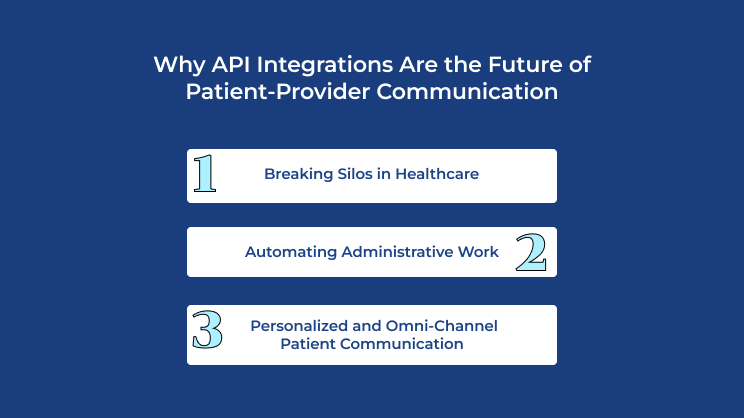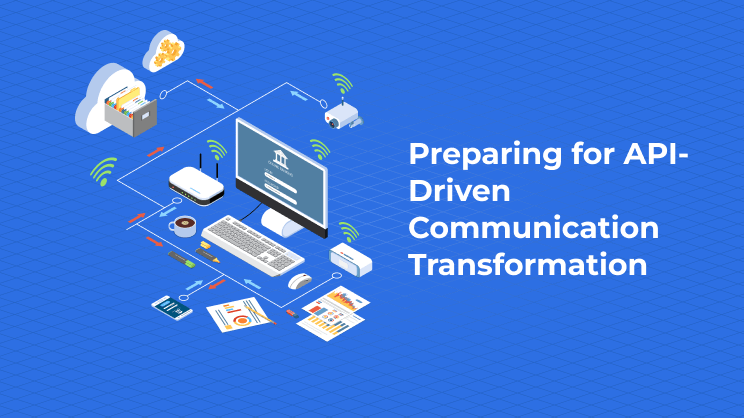Have you fussed over a prescription refill or lab results update and waited days to get a response from your healthcare provider? This is not just frustrating but a systemic issue that millions of patients face daily. Despite outstanding advances in medical technology, one of the most problematic issues of healthcare remains intact- the patient engagement and provider communication gap.
In fact, this communication breakdown isn’t only inconvenient, but it’s also expensive. They are losing revenue and productivity, and patients are becoming unhappy. With digital transformation speeding up across the industry, healthcare API integration has become the solution to bridge these gaps.
At OSP, we have experienced the revolution of how providers connect with patients through API integration in healthcare. Treating the patient experience as a system, APIs simplify and streamline administrative workflow and enable personalized communication.
This blog will focus on the hidden costs of poor communication, the future of the healthcare API, and why enterprises are seriously looking into hospital API implementation in their 2025 strategic planning.
The Hidden Cost of Poor Patient-Provider Communication

1. Revenue and Productivity Losses from Bad Communication
Did you know that 45% of patients miss paying because of communication issues? And that’s just the tip of the iceberg. Bad communication means missed appointments, delayed medical billing, and patient churn. In fact, 59% of patients switch providers because of communication gaps, which translates to huge revenue losses for healthcare systems.
Patients will seek elsewhere if they can’t access their billing information or healthcare appointment scheduling. This affects revenue and strains existing resources as staff spend hours manually following up on missed payments or rescheduling appointments. The medical billing API integration can solve such issues by automatically sending payment reminders and delivering financial information instantly to the patients.
2. Administrative Overload & Burnout
The pandemic accelerated digital adoption but also created new challenges. For example, patient portal messages increased by 157% post-pandemic, overwhelming healthcare staff with fragmented systems. Every task- from scheduling to insurance verification- requires manual intervention, increasing the error risk and staff burnout.
Imagine a scenario where a patient’s insurance information isn’t updated across systems. The result? Hours of manual work for staff and delays for the patient. These inefficiencies are not just inconvenient- they are expensive and unsustainable in today’s healthcare environment.
Why API Integrations Are the Future of Patient-Provider Communication

APIs (Application Programming Interfaces) function as invisible connectors that make communication in healthcare fast, smart, and seamless. Here are the ways in which API in healthcare will change the way patients and providers interact:
1. Breaking Silos in Healthcare
One of the greatest challenges in healthcare is siloed systems. EHR, billing software, and patient portals typically operate in isolation. EHR API integration creates a real-time connection between these systems so patient data can flow between platforms.
Interoperability through APIs can improve care coordination by up to 40% by avoiding manual data entry. If the communication is effective, providers and patients will have a more accurate and timely exchange of information.
2. Automating Administrative Work
One of the biggest advantages of healthcare API integration is its ability to automate repetitive tasks.
Insurance verification works in an instant. Automatic appointment reminders go through the patient’s preferred channel. Payment processing connects directly to the billing system, removing the reconciliation headache.
Collectively, APIs can reduce 70% of the manual admin work in healthcare. This can allow staff to focus on patient care and engagement rather than data entry.
3. Personalized and Omni-Channel Patient Communication
Modern patients expect communication on demand. Some of them prefer text messages, others email, and some want direct phone contact. API integration in healthcare makes omnichannel communication possible through one platform.
A single message can be composed and sent via SMS, WhatsApp, email, or patient portal from one platform, and it will all be tracked for HIPAA compliance and engagement status. This flexibility helps with better patient satisfaction and faster resolution of queries. The Telehealth API integration further extends these capabilities by allowing secure virtual consultation on the same unified communication channel.
How API Integrations Drive Business Growth for Providers

1. Revenue Protection
APIs don’t just communicate; they protect revenue. Automated billing reminders accelerate payments and reduce missed payments. By providing digital experiences, healthcare providers can reduce patient leakage and retain more customers through practice management API integration.
2. Increased Productivity & Staff Efficiency
Healthcare API integration automates manual tasks and thus significantly increases staff productivity. For example, APIs can save providers up to 4 hours per staff member per day. That time can be redeployed to more strategic initiatives like patient care or service expansion.
3. Compliance & Security
In an industry as regulated as healthcare, security is non-negotiable. Cloud healthcare API solutions ensure all communication remains HIPAA compliant, protect patient data, and enable secure data exchange.
Steps to Prepare for API-Driven Communication Transformation

1. Assess Your Organization
First, evaluate your current communication workflows. Identify manual processes, bottlenecks, and patient pain points. Common gaps include manual appointment scheduling, insurance verification delays, or disjointed billing notifications. A thorough assessment will reveal where automation through EMR API integration will have the biggest impact.
2. Partner with API Experts
Choosing the right API partner is key to your communication transformation. Look for providers who offer custom APIs specifically designed for healthcare workflows. Experienced partners understand the regulations, interoperability issues, and how to integrate with various systems. Working with the right experts will speed up the implementation and ensure your APIs deliver long-term value.
3. Continuous Support & Scalability
API integration isn’t a one-time project- it’s an ongoing journey. As patients’ expectations and technology evolve, your communication systems must keep pace. Invest in future-proof APIs that receive regular updates, security patches, and scalability. Telemedicine API integration is an excellent example of how a healthcare organization can continuously increase its digital footprint to adapt to the patient’s changing needs.
Final Thoughts
The API, with interoperability, is the future of patient-provider communication. Healthcare API integration helps automate workflows, break communication silos, and provide personalized communication channels in the healthcare industry.
APIs are an investment for better patient care, operational efficiency, and sustainable revenue growth for healthcare providers. Benefits are not limited to technological advancement but include increased patient satisfaction, safeguarding revenue lines, reducing administrative burden, and stimulation of care coordination that results in healthier practices and improved patient outcomes.
With healthcare delivery models becoming increasingly digital, organizations that adopt healthcare API integration will gain a lot of competitive advantage. Those who are early adopters will be in a better position to adjust to changing patient expectations and maximize their internal operations for the highest efficiency possible.
The post The Future of API Integrations: Launching Seamless Patient-Provider Communication appeared first on Osplabs.





